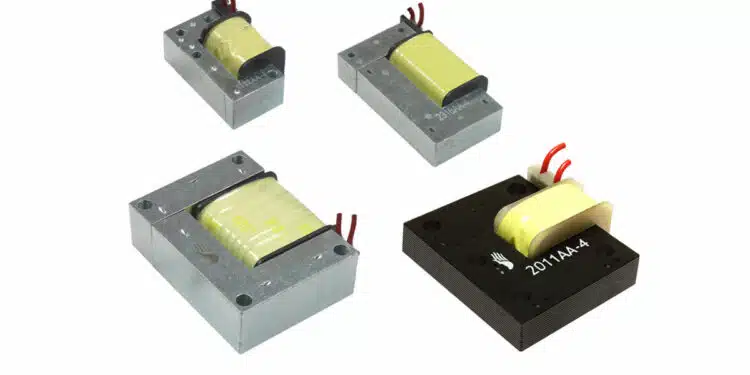Vishay Intertechnology announced that it has expanded its lineup of IHPT solenoid-based haptic actuators featuring Immersion Corporation licenses, with five new devices offering additional sizes and force levels.
Providing 12 V operation for LCD displays, touchscreens, touch switches, and button control panels for human-machine interfaces (HMI) in automotive and commercial applications, the Vishay Custom Magnetics actuators deliver high pulse and vibration capability for clear, high definition (HD) tactile feedback.
Available in four sizes from 29 mm by 21 mm to 44 mm by 37 mm — with variable force output up to 120 N — the devices released today feature a compact, two-piece construction with mounting holes for easy installation and direct application of force. The actuators’ fast response time of 5 ms — combined with their high mechanical force — allow them to produce HD haptic effects with operating voltages from 8 V to 16 V.
The IHPT actuators are perfect for rugged, noisy environments where audio tones may not be adequate to communicate actuation to the user. The devices feature a robust, rigid copper and iron core construction and high temperature operation to +105 °C for high reliability in the most exacting of applications.
The Automotive Grade, AEC-Q200 qualified IHPT1411AFELR73ABA will be used in automotive dashboards and center consoles, and can provide tactile feedback for electronic shift transmissions, steering wheels, seats, and other in-vehicle controls.
Typical applications for the IHPT1207AGELR39AB0, IHPT1710ACEL1R2AB0, IHPT1411AFELR73AB0, and IHPT1614ACEL2R7BB0 will include factory automation and control systems; consumer appliances and entertainment and health devices; and medical, military, avionics, and studio audio equipment. Due to licensing restrictions, the actuators are not available for certain applications, including gaming.
The electromagnetic devices’ low nominal 12 V operation eliminates the need for the additional high voltage circuitry required by other technologies. As a result, the IHPT series can be implemented at a lower cost than competing technologies — including linear resonant, linear wideband, eccentric rotating mass, and piezo actuators — while reducing component height and delivering higher force density. The devices come bundled with Immersion licenses, so the design-in process is streamlined and costs are lowered further by eliminating the need to purchase a separate license to implement sophisticated haptic effects.
The IHPT actuators can drive a 0.5 kg load to 6 g of acceleration with a 12 V, 5 ms pulse. Their driving coils offer inductance down 1.8 mH, typical DCR down 0.95 W, and a coil to core dielectric withstand voltage of 150 VDC. RoHS-compliant, halogen-free, and Vishay Green, the devices’ standard lead terminations are dipped in 100 % tin solder. Vishay can customize the actuators’ size, shape, and core material; number of windings; termination types; and performance to any design’s specifications.
































